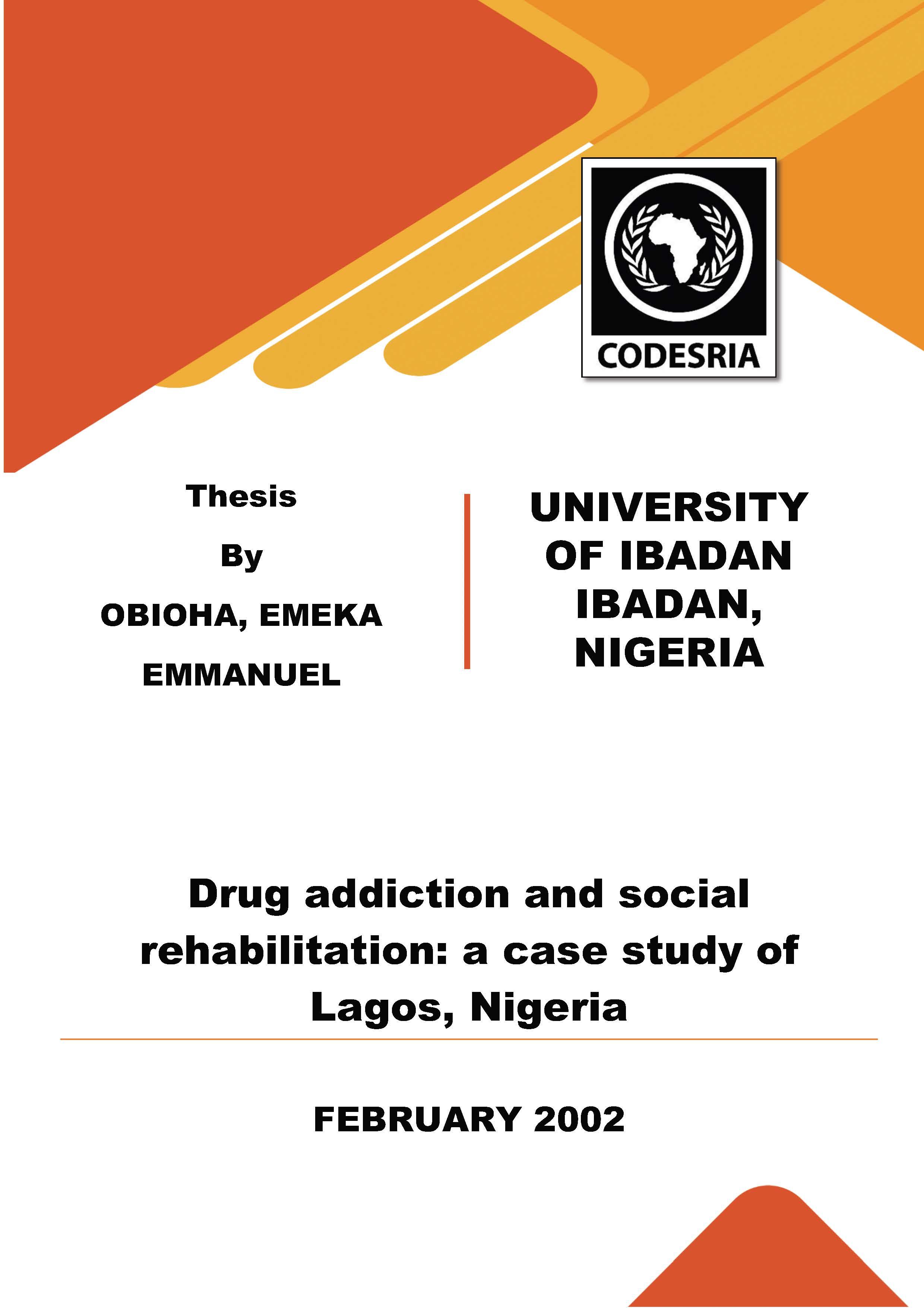Drug addiction and social rehabilitation: a case study of Lagos, Nigeria
Mots-clés :
Drug, addiction, social rehabilitation, Lagos, NigeriaSynopsis
Existing literature shows that drug addiction is one of the contemporary social problems in the Nigerian society. There is persistent increase in the number of drug addicts who need rehabilitation, and those who have undergone rehabilitation without much success in our society. This indicates that much ground is yet to be covered in drug addiction studies in Nigeria. The scenario further suggests that there is little understanding of the factors related to the problem of drug. addiction and successful rehabilitation. Most of the existing literature Jack information on the interface between drug addiction and sustainable care and support programmes in Nigeria, especially from sociological and anthropological perspective. Against this background, the main objectives of this study are to describe the patterns of drug addiction, to describe the initiation
processes, and to identify the social background factors influencing patterns of drug addiction. The study also examines the existing rehabilitation opportunities and their effectiveness, the response of the drug addicts under rehabilitation, and the obstacles hindering the rehabilitation processes.
This study focuses on drug addicts who seek care in psychiatrie, social welfare, and faith-based rehabilitation centres in Lagos. The study makes use of a sample size Qf 430 subjects proportionately selected from some chosen centres. The questionnaire schedule, in-depth interview guide, key informant interview guide, and observations are the instruments of data collection. The study adopts the Discriminant Analysis, Independent Samples Test (T-Test) One Way Analysis of Variance (ANOV A), Chi-square test, and Logistic Regression for comparative and inferential purposes in the quantitative data analyses, and content analysis for the qualitative data sorting.
The major finçlings of this study using the Discriminant model are first, that there are two patterns of drug addiction, namely "Progressive addiction" and "Stable hard addiction". The first connote a process starting from the use of soft drugs to the hard drug, while the latter involves initiation into drug use with hard drug without a shift in later usage. Second, drug addiction mainly begins with soft drugs and ends up with the hard drugs. This confirms the stepping stone theory of drug addiction. Involvement in drug use starts at a mean age of 16years, while average ages of 16 and 24 are for the progressive and stable hard addiction respectively. The study also found that peer group is the major source of introduction to drug use followed by self-experimentation. The discriminant model also reveals that family discipline, family stability, location of residence, criminality, family size, ,parental s9cial status, parental supervision and family affection are significant social background factors influencing pattern of drug addiction. Economie and social life problems, especially breakdown on work and familial relationship are found to be prominent in the period of drug addiction.
The study further reveals the importance of family members as the major sources of referral to the rehabilitation. However, the chi-square test of difference shows that faith-based rehabilitation approach is the most effective system of rehab~U~ting the drug .acl.dicts over the social. welfare, and psychiatrie centres. Inaddition, a sigilificant relationship is found between category of addiction and adjustment pattern. Comparatively the progressive addiction is found to be moredifficult to manage than the stable bard addiction. U sing the Logistic RegressionModel in assessing the contribution of selected socio-demographic, drug history, and rehabilitation variables, only method of rehabilitation and category of addiction l have impact on clients' adjustment pattern in the drug rehabilitation centres. Sex, age, age at first drug use, rehabilitation residence status, among
others do not have any significant impact in the model.
These results ·have implicàtions for sustainable, care and support programmes for drug addicts in Nigeria. These further show the influence of drug history and social background contexts on drug addiction, which is an important clue for designing a successful rehabilitation Programme. Programmes should therefore be designed to accommodate these individual and group differences. The study also suggests a comprehensive social rehabilitation approach that will involve the integration of the faith-based, social welfare, and psychiatrie approaches in one process. Finally, civil society organizations should be encouraged through enabling Iegislation in participating in worthwhile effort.
Téléchargements
Références
Power R, Jones, S. Keams G, Ward, J, and Perera J, (1995) "Drug User Network, Coping Strategies, and HIV Prevention in the Community" Journal of Drug Issues, 25(3) 565 -581; 1995.
Power, M. J., Benn, R.T., and Monis, J. N. (1972) "Neighbourhood Schools, and Juveniles before the Courts". British Journal ofCriminology, 12; li 1-132.
Power, R and Jones, S. (1993), Lifestyles (Part Two) Coping Strategies of Illicit Drug Users; Final Report to the Dept. ofHealth. Lond.
Pretoria Mental Hospital, Medical Staff, Mental System Association with The Smoking of dega. South African Medical, Journal. Feb. 12, 1938. 85 - 88.
Prins Herschel (1980) Offenders or Patients. An Introduction to the study of Socio - Forensic Problems: Tavistock Pub. Lond. -0
Printice D. A and Miller D. F. (1993) "Pluralist Ignorance and Alcohol Use: Sorne Consequences ofMisperceiving the Norm". Journal of Personality and Social Psychology. 64(2) 243 - 256.
Radke - Yarrow M, Zahn Waxler C, and Chapman M (1983) "Prosocial Dispositions and Behaviour". ln P Mussen (Ed) Manual of Child Psychology. Vol. 4; Socialization, Personality and Social Development (Pp
- 545) (Em Hethermgton Ed) New York, Wisly.
Raffoul, P. R. and Cummins, M. J. (1980) "Voluntary Reduction in Cannabis Use among Graduate Students'.'. The International Journal. of Addiction 15; 647-656.
Raveis, V. H. and Kandal, MD. B. (1987) "Changes in Drug Behaviour from the middle to the late twenties; Initiation, Persistence and Cessation of Use".
American Journal of Public Health. 77: 607-611.
Raviv A, Bar-Tal D, Ayalon H, and Raviv A (1980) "Perception of Giving and Receiving Help by Group members". Representative Research in Social Psychology, II 140-151.






